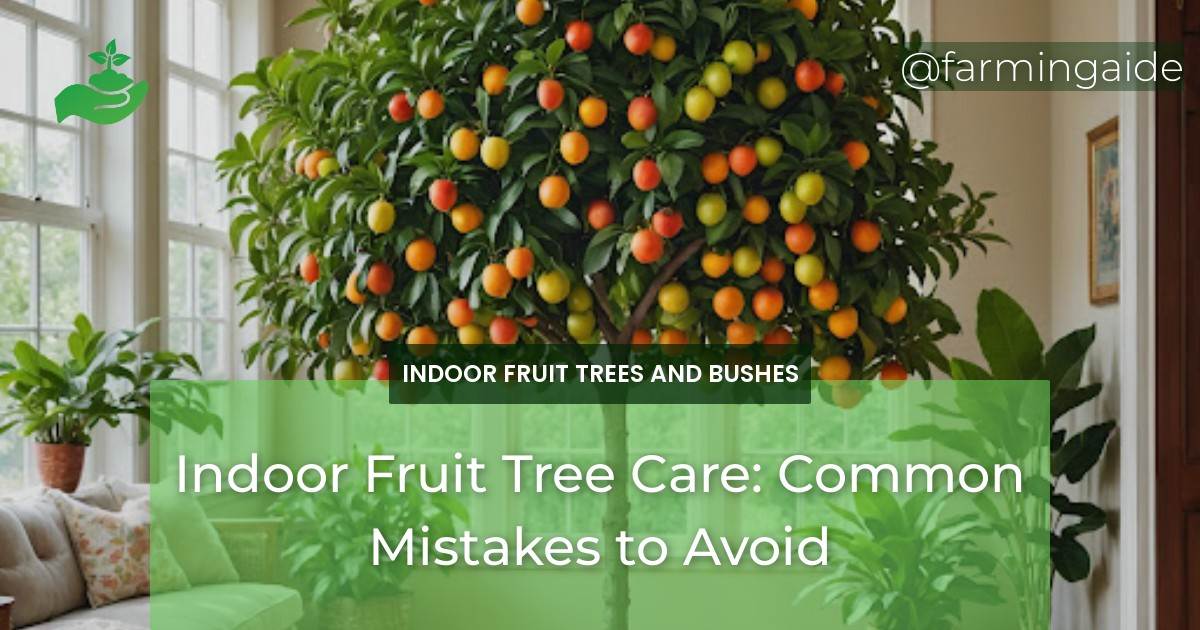Are you eager to grow a thriving indoor fruit tree, but struggling to keep it healthy and productive? You’re not alone! Many indoor gardeners make common mistakes that can hinder the growth and success of their fruit trees. In this article, we’ll explore the top mistakes to avoid when it comes to indoor fruit tree care, so you can enjoy a bountiful harvest and a thriving indoor garden. One common mistake that can hinder indoor fruit tree growth is overwatering. It’s important to allow the soil to dry out slightly between waterings to prevent root rot. Additionally, using the wrong type of soil or insufficient lighting can also negatively impact the health of your fruit tree. Another important aspect of indoor fruit tree care is identifying common pests, such as aphids or spider mites, and taking measures to address them promptly to keep your tree healthy and productive.
Key Takeaways
- Avoid incorrect planting techniques, such as using the wrong pot size or soil type.
- Provide optimal light exposure, tailored to your tree’s specific needs.
- Water correctly, avoiding overwatering and underwatering.
- Regularly prune and maintain your tree to promote healthy growth.
- Monitor for pests and diseases, taking preventative measures and treating issues promptly.
Introduction to Indoor Fruit Tree Care
Indoor fruit trees can bring a touch of tropical paradise to your home, providing delicious fruit and a sense of accomplishment. However, they require specific care to thrive.
With the right techniques and attention, you can enjoy a thriving indoor fruit tree that produces abundant fruit and adds beauty to your home.
Importance of Indoor Fruit Trees
Indoor fruit trees offer numerous benefits, including:
- Fresh, homegrown fruit year-round
- Purified air and a natural ambiance
- Aesthetic appeal and decorative value
- A sense of accomplishment and connection to nature
Common Types of Indoor Fruit Trees
Popular indoor fruit trees include:
- Citrus trees (dwarf Washington navel oranges, lemons, limes)
- Dwarf apple trees
- Figs
- Pomegranates
- Banana trees
Mistake 1: Incorrect Planting Techniques
A successful indoor fruit tree starts with proper planting. Avoid these common mistakes:
ALSO READ
Choosing the Right Pot
Select a pot that is:
- At least 1-2 sizes larger than the tree’s current pot
- Well-draining, with holes in the bottom
- Made of a durable, non-toxic material
Soil and Fertilizer Selection
Use a high-quality potting mix specifically designed for fruit trees, and:
- Fertilize regularly, following the manufacturer’s instructions
- Monitor soil pH, adjusting as necessary
Mistake 2: Inadequate Light Exposure
Light is essential for fruit tree growth and production. Ensure your tree receives:
ALSO READ
Optimal Light Requirements
Research the specific light needs of your tree, as some require:
- DIRECT sunlight (4-6 hours)
- BRIGHT, INDIRECT sunlight (4-6 hours)
- FILTERED or DAPPLED light (2-4 hours)
Solutions for Limited Light
If you can’t provide direct sunlight, consider:
- Using grow lights or LED lamps
- Placing the tree near an east- or west-facing window
- Supplementing with artificial lighting
Mistake 3: Overwatering or Underwatering
Watering mistakes can be detrimental to your tree’s health. Avoid:
Signs of Overwatering
Look for:
- Yellowing or droopy leaves
- Soft, mushy stems
- Waterlogged soil
Signs of Underwatering
Monitor for:
- Wilted or crispy leaves
- Brittle, dry stems
- Soil that feels dry to the touch
Mistake 4: Neglecting Pruning and Maintenance
Regular pruning and maintenance are crucial for a healthy, productive tree.
The Importance of Pruning
Pruning:
- Promotes healthy growth and air circulation
- Encourages fruiting and flowering
- Removes diseased or damaged branches
Regular Maintenance Practices
Regularly:
- Inspect your tree for pests and diseases
- Fertilize and repot as necessary
- Monitor temperature and humidity levels
Mistake 5: Ignoring Pest and Disease Management
Regularly monitor your tree for signs of pests and diseases, and:
Be on the lookout for:
- Aphids, whiteflies, and spider mites
- Fungal diseases like powdery mildew and root rot
Preventative Measures and Treatments
Treat infestations promptly, using:
- Insecticidal soap or neem oil
- Fungicides, as necessary
- Cultural practices like pruning and sanitation
Conclusion and Final Tips
By avoiding these common mistakes, you’ll be well on your way to growing a thriving indoor fruit tree. Remember to:
Recap of Common Mistakes
Avoid incorrect planting techniques, inadequate light exposure, overwatering or underwatering, neglecting pruning and maintenance, and ignoring pest and disease management.
Encouragement for Successful Indoor Fruit Tree Care
With patience, attention to detail, and a willingness to learn, you can enjoy a bountiful harvest and the many benefits of indoor fruit tree care. Happy growing!
| Common Mistake | Solution |
|---|---|
| Incorrect Planting Techniques | Choose the right pot, soil, and fertilizer |
| Inadequate Light Exposure | Provide optimal light, using grow lights or LED lamps if necessary |
| Overwatering or Underwatering | Monitor soil moisture, watering correctly |
| Neglecting Pruning and Maintenance | Regularly prune and maintain your tree |
| Ignoring Pest and Disease Management | Monitor for pests and diseases, taking preventative measures and treating issues promptly |


